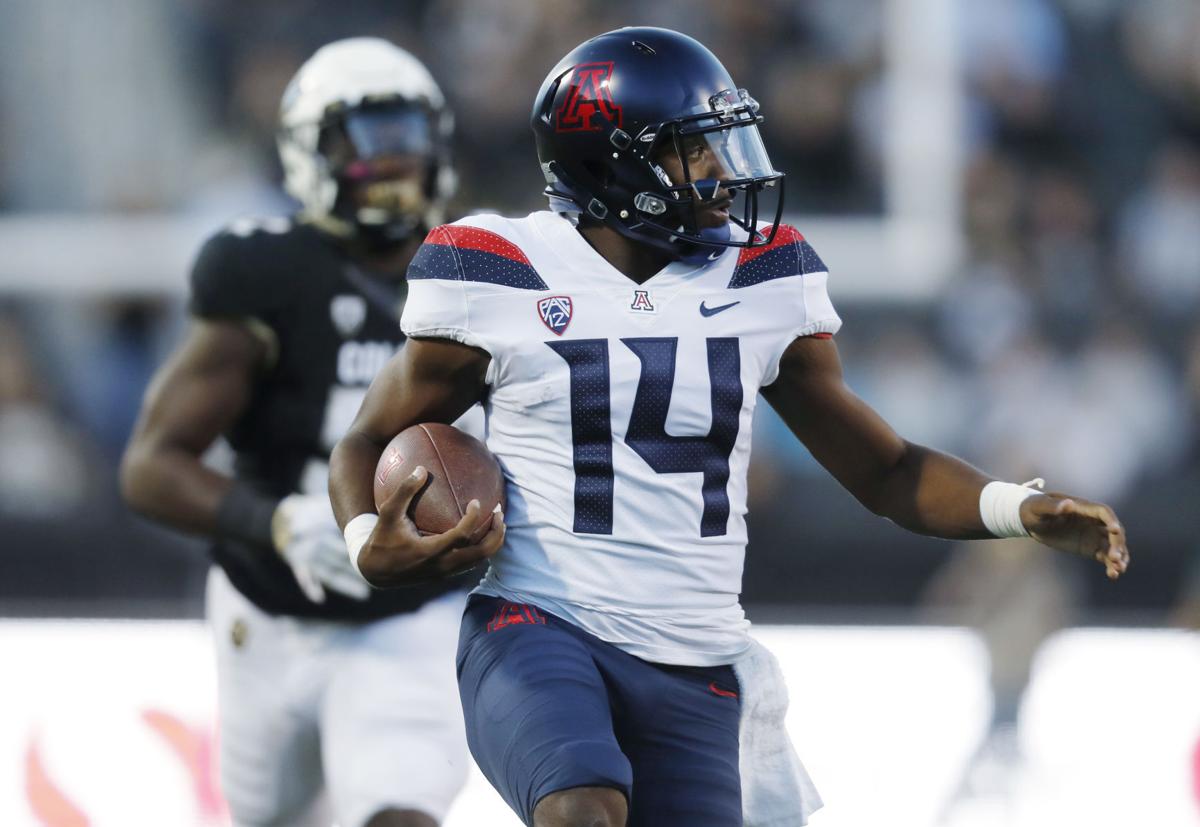Arizona Wildcats quarterback Khalil Tate was so effective at Colorado on Saturday night that he continued to accumulate stats the following day.
A scoring change Sunday gave Tate 12 additional passing yards. It improved his passing line to 12 of 13 for 154 yards.
Of course, it was Tate’s rushing that made him an overnight sensation.
The sophomore ran for 327 yards and four touchdowns — covering 58, 28, 47 and 75 yards — on a scant 14 carries in Arizona’s 45-42 victory in Boulder. He broke the single-game FBS rushing record for a quarterback, and his 481 yards of total offense were the fifth most in UA history.
The Walter Camp Football Foundation on Sunday named Tate its National Offensive Player of the Week. CBS Sports named him its National Player of the Week, offense or defense.
He’s sure to be named Pac-12 Offensive Player of the Week on Monday.
Searching Tate’s name on Google on Sunday afternoon produced more and different results than it would have 24 hours earlier. Many of the headlines on national websites referred to Arizona’s “backup” quarterback breaking the QB rushing record. That adjective is no longer applicable.
UA coach Rich Rodriguez indicated after the Colorado game that Tate would start against UCLA on Saturday. The quarterback essentially gave him no choice.
Tate made his college debut last season against the Bruins, and it appears he will make his second career start against them at Arizona Stadium. That will please the fan base, which has been seeking a quarterback change for weeks.
The told-you-so crowd was out in full force on social media Saturday night. But it’s important to note that Rodriguez couldn’t have switched from Brandon Dawkins to Tate even if he had wanted to.
Tate suffered a sprained throwing shoulder in the Sept. 2 opener against Northern Arizona. He never appeared on the injury report, but he said Saturday that he wasn’t fully healthy until last week.
“It was real bad,” Tate said. “I had an AC sprain. It’s kind of like spraining your ankle. You can’t put pressure on it. It’s like not being able to throw the ball with your right (arm), and I’m a right-handed quarterback.”
Tate played in the fourth quarter in Week 2 against Houston when Dawkins was hurt but clearly wasn’t himself. Tate couldn’t throw downfield, and he was shaking his arm to try to loosen it between plays.
Tate didn’t play the following two weeks. Dawkins had the best game of his career at UTEP before struggling against Utah. He had to leave the Colorado game in the first quarter because of injury. Now the job appears to be Tate’s to lose.
“He’s a baller,” senior defensive end-linebacker DeAndre’ Miller said. “He carried us as a team, so all credit to him.
“He’s young. I know he has potential. This game allowed him to show it to the world.”
Finally, Miller time
Miller made his 2017 debut against the Buffaloes after sitting out the first four games because of a foot injury.
Miller described the injury, which he suffered in July, as a stress fracture caused by “overworking my body.”
“It was my senior year. I was trying to do everything possible,” Miller said. “Me sitting on the couch felt like somebody was doing better than me. So I was always active.”
The oft-injured Miller said he feels 100 percent healthy. He said he targeted the Colorado game for his return “to play it safe.” Arizona had a bye the week before last, giving Miller extra time to prepare.
Miller rotated with starting “Stud” Kylan Wilborn and had four tackles, including three solo stops. Miller didn’t record any of the Wildcats’ season-high four sacks, but his teammates noticed his presence.
“He’s a leader,” junior cornerback Jace Whittaker said. “Having him in the locker room, seeing him get ready, it just brings that energy that not everyone will see unless you’re on the team.”
Scoring too fast?
Tate was so difficult to corral that it might have worked against Arizona’s defense.
Two scoring drives lasted one play apiece — Tate’s runs of 58 and 75 yards. Three others consisted of no more than six plays and consumed a maximum of 2 minutes, 20 seconds of clock time.
Meanwhile, each of Colorado’s six touchdown drives featured a minimum of six plays from scrimmage. Four consisted of 10 or more plays, and one lasted 19 plays and more than nine minutes.
At one point in the third quarter, the Buffaloes had run more than twice as many plays as the Wildcats — 65 to 30. The final tally was 90 to 56.
So is it possible to score too fast?
“There’s no such thing,” Rodriguez said, “unless it’s the last five minutes of the game.”
Arizona slowed its no-huddle offense in the fourth quarter to try to milk the clock.
Extra points
- Arizona finished with a 16-yard advantage in total offense (567-551) — and a 100-yard edge in penalty yardage. The Wildcats were flagged two times for 10 yards, the Buffs 12 for 110.
- Arizona rushed for 413 yards, marking the third time in the past six games that it has rushed for at least 300. The Wildcats have rushed for at least 150 yards in 11 straight games.
- Arizona opened as a two-point favorite over UCLA. The line had dropped to 1ƒ as of Sunday night.





